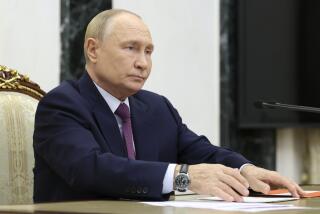New Nuclear Policy Makes for a Safer World
- Share via
The Bush administration’s new nuclear policy has received a great deal of criticism over its suggestion that U.S. nuclear weapons play a role in deterring hostile nations that don’t possess nuclear weapons but are armed with other kinds of weapons of mass destruction.
The criticism--that the new policy lowers the bar for use of nuclear weapons--is misplaced. In fact, by linking U.S. nuclear and conventional precision strike capabilities, the policy narrows the role of nuclear weapons in U.S. defense policy, reduces the circumstances in which they might be used and sets the stage for even deeper cuts in nuclear forces.
The planned reduction in nuclear warheads deployed with operational submarines, bombers and land-based missiles--from about 6,000 to between 1,700 and 2,200--is quite an accomplishment. It will decrease the cumulative risk of technical mishaps and unauthorized or inadvertent launches, and it should reassure the Russians politically by moving the U.S. to a force level that Russia appears to be seeking itself.
Critics of the new policy have complained that many of the warheads coming off U.S. forces will be placed in reserve rather than dismantled immediately. Getting 4,000 warheads off alert is very important in its own right. It would take time to put the weapons back on missiles or into active bomber inventories. Given the international furor that would accompany such a move, no president would take it without very serious reason.
Meanwhile, having the option to beef up U.S. forces is only sensible given the uncertainties of world events. As Secretary of Defense Donald Rumsfeld has said, when it comes to international threats “the only surprise is that we’re surprised when we’re surprised.”
Weapon and stockpile requirements are reviewed periodically. If international developments continue favorably, either further reductions in operational weapons or the destruction of stockpiled weapons would certainly be possible.
The new policy recognizes that Russia is no longer our enemy, and there is no longer a need to plan for massive attacks against that nation. It would move the U.S. away from a single, integrated operational plan for nuclear attacks to “capabilities-based targeting.” Instead of massive, society-destroying nuclear strikes, the U.S. would plan to have capabilities to conduct limited nuclear strikes aimed at specific objectives. In its classified form, the policy mentioned nations for which planners need to prepare such options, causing a furor. The only thing new here from previous administrations is that the names of the nations leaked out.
In its most important development, the new defense policy pairs U.S. nuclear forces with precise, conventional strike capabilities. In this formulation, the new policy greatly circumscribes the potential role of nuclear weapons. Recognizing the immense capabilities of modern aircraft and missiles armed with conventional weapons, the new policy implies that for the first time in 50 years the U.S. may not have to respond to nuclear threats in kind. We may be able to defeat such threats by attacking enemies with conventional weapons, relying on missile defenses to stop any threatening forces that survive. This is a huge change in thinking, allowing for even more nuclear-force reductions as conventional strike and missile defense capabilities advance.
Administration officials have a way to go before the new policy is fulfilled. They have to work closely with the U.S. Strategic Command to ensure that the planned changes in targeting are implemented properly. The nuclear departures of more than one previous administration have been thwarted in their implementation phase. And the administration will have to move expeditiously to set in place the transparency measures and other arrangements to reassure the Russians and others that the shift from negotiated arms control agreements to unilateral reductions in forces is not a subterfuge.
These steps notwithstanding, the new policy is a major accomplishment and an important advance toward ending nuclear dangers.
More to Read
Sign up for Essential California
The most important California stories and recommendations in your inbox every morning.
You may occasionally receive promotional content from the Los Angeles Times.










